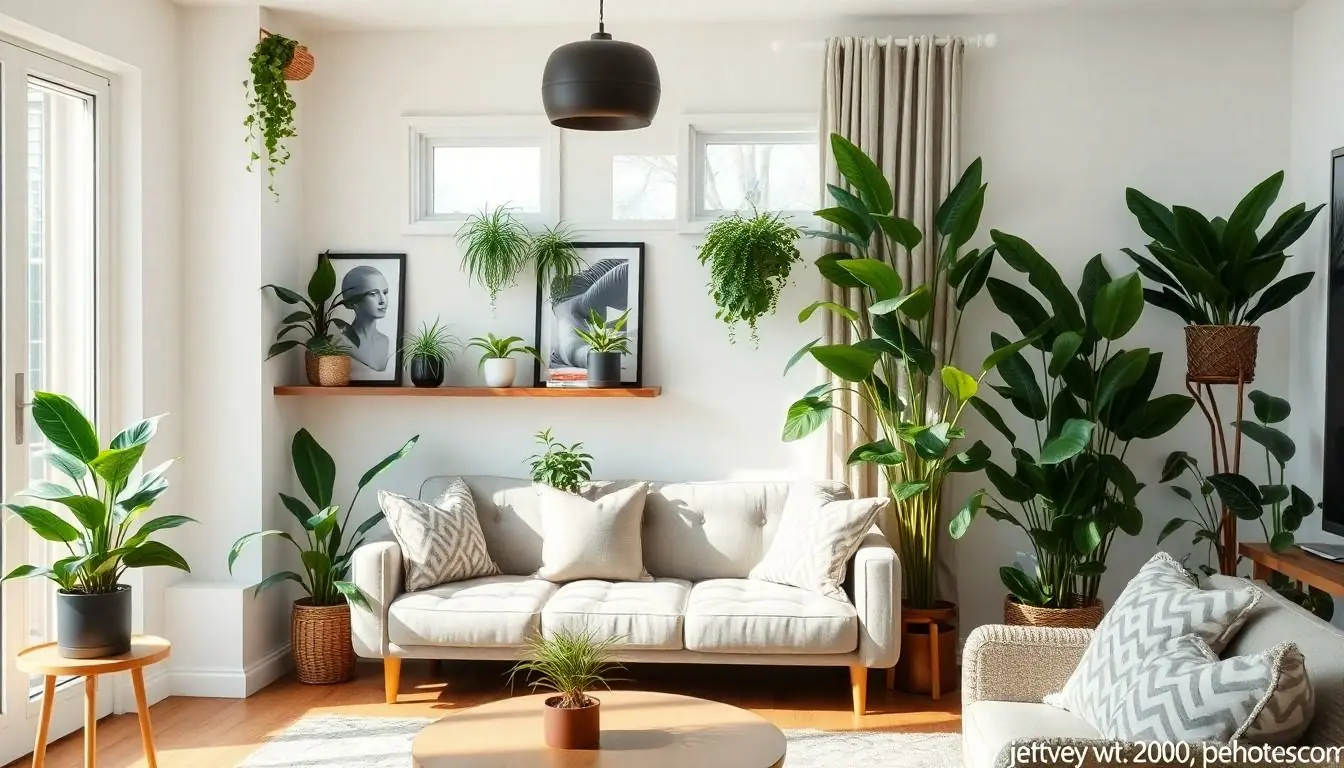Table of Contents
ToggleIf you think your home is too dark for plants, think again! Shade-loving house plants are the unsung heroes of indoor greenery, thriving in low-light conditions while adding a splash of life to those dim corners. They might not bask in the sun like their sun-worshipping counterparts, but these leafy companions have a charm all their own.
Overview of Shade Loving House Plants
Shade-loving house plants thrive in low-light environments, making them suitable for darker areas of the home. These plants offer a variety of textures and colors, enhancing the aesthetic appeal of any space. A few common examples include snake plants, pothos, and peace lilies, which adapt well to limited sunlight.
Snake plants, known for their upright leaves, tolerate neglect and occasional watering. Pothos, with its trailing vines, grows well in low light while purifying the air. Peace lilies bloom beautiful white flowers, providing contrast against their verdant leaves.
Low-light conditions do not mean a lack of growth vigor. Many shade-loving plants exhibit impressive resilience, adapting to varying environmental conditions. These plants generally require less maintenance, making them ideal for busy individuals or those new to gardening.
Fertilization requirements for these plants often differ from those needing bright light. During the growing season, a balanced fertilizer applied monthly supports their health. The frequency of watering usually depends on individual plant needs, but it’s best to let the soil dry out slightly between waterings.
Consider the placement of these plants to maximize their growth. Bathrooms, low-light living rooms, and offices can benefit from the addition of shade-loving varieties. With careful selection and placement, anyone can enjoy the beauty and benefits of these resilient house plants.
Benefits of Shade Loving House Plants

Shade-loving house plants offer numerous advantages, especially for indoor environments with limited sunlight. These plants not only enhance spaces but also contribute positively to overall well-being.
Improved Indoor Air Quality
Improved indoor air quality is a notable benefit of shade-loving house plants. Plants such as peace lilies and snake plants effectively filter toxins like formaldehyde and benzene from the air. They also increase humidity levels, promoting better respiratory health. Research shows that indoor plants can remove up to 87% of harmful pollutants within 24 hours. Incorporating these plants into living spaces boosts air quality, making environments healthier for occupants. Moreover, better air quality leads to increased productivity and reduced stress levels.
Aesthetic Appeal
Aesthetic appeal is another significant benefit attributed to shade-loving house plants. Important for enhancing interior design, these plants add vibrant greenery and diverse textures to any space. Variations in leaf shape and color provide visual interest, complementing various decor styles. Snake plants bring an architectural flair, while pothos drapes beautifully from shelves. Placing these plants in lower-light areas creates inviting atmospheres, transforming mundane corners into lively focal points. Additionally, their adaptability allows for creative arrangements, enhancing the overall aesthetic of any room.
Popular Types of Shade Loving House Plants
Shade-loving house plants offer various options that thrive in lower light conditions. Their unique characteristics enhance indoor spaces while improving air quality.
Ferns
Ferns excel in low-light environments, making them ideal for shaded corners. These plants prefer a humid atmosphere, which can be provided through regular misting. Varieties such as Boston ferns and maidenhair ferns stand out with their intricate leaf patterns. They typically grow well in pots or hanging baskets. Providing indirect sunlight promotes lush growth, while avoiding direct light prevents leaf burn.
Snake Plants
Snake plants are known for their air-purifying abilities and resilience in low light. They tolerate infrequent watering, making them low-maintenance options for busy lifestyles. Vertical leaves grow upright, adding a modern touch to any room. Ideal locations for snake plants include bathrooms and windowless spaces. They thrive on neglect, flourishing even when forgotten.
Pothos
Pothos thrives in a range of lighting conditions, particularly in shaded areas. This fast-growing vine adapts easily, making it a popular choice among plant enthusiasts. Varieties such as golden pothos and marble queen display vibrant, variegated leaves. Pothos enjoys regular pruning, which encourages bushier growth. Placing them on shelves or in hanging baskets enhances their trailing effect and visual appeal.
Care Tips for Shade Loving House Plants
Understanding the care requirements of shade-loving house plants ensures they thrive in low-light conditions. Following specific guidelines promotes their growth and longevity.
Light Requirements
These plants prefer indirect light or filtered sunlight. Positioning them near north or east-facing windows optimizes their light exposure. Avoid placing them in direct sunlight, as this can scorch their leaves. Optimal lighting for these plants varies by type, but typically, bright, indirect light benefits most. It’s essential to monitor the plant’s response to the light and adjust accordingly. If leaves begin to yellow, the plant may require more light.
Watering and Humidity
Watering should occur when the top inch of soil feels dry. Overwatering poses a risk, leading to root rot and other issues. Incremental watering helps maintain soil moisture levels without saturation. High humidity benefits many shade-loving plants, with a target range of 40 to 60 percent ideal for growth. Increasing humidity through misting, pebble trays, or humidifiers is beneficial. Regularly checking the moisture levels and adjusting care routines supports optimal plant health.
Shade-loving house plants offer a wonderful opportunity to bring life into darker areas of the home. Their ability to thrive in low-light conditions makes them perfect companions for those who may struggle with bright sunlight. With a variety of options available from snake plants to pothos, these plants not only improve air quality but also enhance the overall aesthetic of any space.
By following proper care guidelines and understanding their unique needs, anyone can successfully incorporate these resilient plants into their living environment. Embracing shade-loving house plants can transform neglected corners into vibrant displays of greenery, contributing to a healthier and more inviting home.




